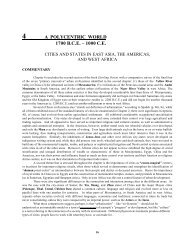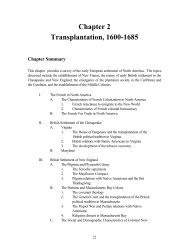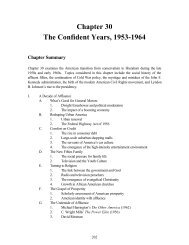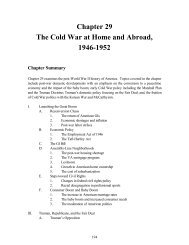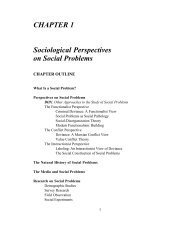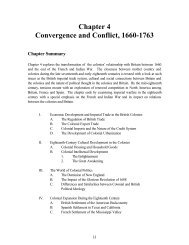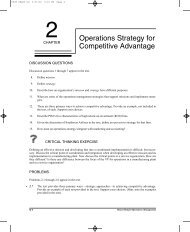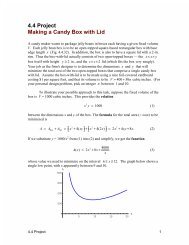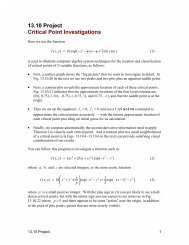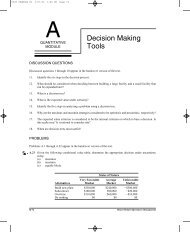Merchandising Operations and the Accounting Cycle - Pearson
Merchandising Operations and the Accounting Cycle - Pearson
Merchandising Operations and the Accounting Cycle - Pearson
You also want an ePaper? Increase the reach of your titles
YUMPU automatically turns print PDFs into web optimized ePapers that Google loves.
Wal-Mart<br />
1 2 3 4 5 6<br />
Austin Sound Centre Inc.<br />
1 2<br />
Jan. Mar. June Sept. Dec.<br />
Measuring Cost of Goods Sold <strong>and</strong><br />
Inventory Purchases in <strong>the</strong> Periodic<br />
Inventory System<br />
7.0 times<br />
per year<br />
2.3 times<br />
per year<br />
The perpetual inventory accounting system that we have illustrated is designed to<br />
produce up-to-date records of inventory <strong>and</strong> cost of goods sold. That system provides<br />
<strong>the</strong> data for many day-to-day decisions <strong>and</strong> for preparation of <strong>the</strong> financial statements.<br />
However, managers have o<strong>the</strong>r information needs that <strong>the</strong> perpetual inventory<br />
system does not meet. For example, <strong>the</strong> buyers for The Forzani Group Ltd. <strong>and</strong><br />
Austin Sound Centre Inc. must know how much inventory to purchase in order to<br />
reach <strong>the</strong>ir sales goals.<br />
Ano<strong>the</strong>r computation of cost of goods sold—from <strong>the</strong> periodic inventory system—helps<br />
managers plan <strong>the</strong>ir purchases of inventory. This alternative computation<br />
of cost of goods sold is used so often in accounting that your education would<br />
be incomplete without it. (The supplement at <strong>the</strong> end of <strong>the</strong> chapter covers <strong>the</strong> periodic<br />
inventory system in more detail.)<br />
Exhibit 5-12 gives <strong>the</strong> alternative computation of Austin Sound Centre Inc.’s cost<br />
of goods sold for 2004. Austin Sound began <strong>the</strong> year with inventory of $38,600.<br />
During <strong>the</strong> year, Austin Sound purchased more goods, also paying freight charges.<br />
The sum of <strong>the</strong>se amounts make up Austin Sound’s cost of goods available for sale.<br />
Note that net purchases equals purchases minus purchase discounts <strong>and</strong> purchase<br />
Beginning inventory....................................... $ 38,600<br />
+ Net purchases ............................................ 87,200*<br />
+ Freight in ..................................................... 5,200<br />
= Cost of goods available for sale ............... 131,000<br />
– Ending inventory ....................................... (40,200)<br />
= Cost of goods sold......................................<br />
*Computation of Net purchases:<br />
$ 90,800<br />
Purchases..................................................... $ 91,400<br />
– Purchase discounts .................................... (3,000)<br />
– Purchase returns <strong>and</strong> allowances ............ (1,200)<br />
= Net purchases ............................................. $ 87,200<br />
Exhibit 5-11<br />
Rate of Inventory Turnover for<br />
Two Merch<strong>and</strong>isers<br />
REAL WORLD EXAMPLE<br />
Many business use <strong>the</strong> gross<br />
margin percentage (also known as<br />
<strong>the</strong> markup percentage) as a<br />
means of determining how well<br />
inventory is selling. If too much<br />
inventory is purchased <strong>and</strong> it must<br />
be marked down, <strong>the</strong> gross margin<br />
percentage will decline. By<br />
monitoring <strong>the</strong> gross margin<br />
percentage, problems can be<br />
corrected quickly.<br />
OBJECTIVE 6<br />
Compute <strong>the</strong> cost of goods sold<br />
under <strong>the</strong> periodic inventory<br />
system<br />
WORKING IT OUT<br />
Calculate inventory turnover given<br />
<strong>the</strong> following data:<br />
Beg. inventory..............$ 2,350<br />
End. inventory..................1,980<br />
Purchases ......................14,550<br />
Freight in.............................390<br />
A: Cost of goods sold/Avg. inv.<br />
Inv. turn. = $15,310*/ $2,165**<br />
= 7.1 times<br />
*$2,350 + $14,550 + $390 – $1,980<br />
= $15,310<br />
**($2,350 + $1,980)/2 = $2,165<br />
EXHIBIT 5-12<br />
Measuring Cost of Goods<br />
Sold in <strong>the</strong> Periodic Inventory<br />
System<br />
Chapter Five <strong>Merch<strong>and</strong>ising</strong> <strong>Operations</strong> <strong>and</strong> <strong>the</strong> <strong>Accounting</strong> <strong>Cycle</strong> 247



